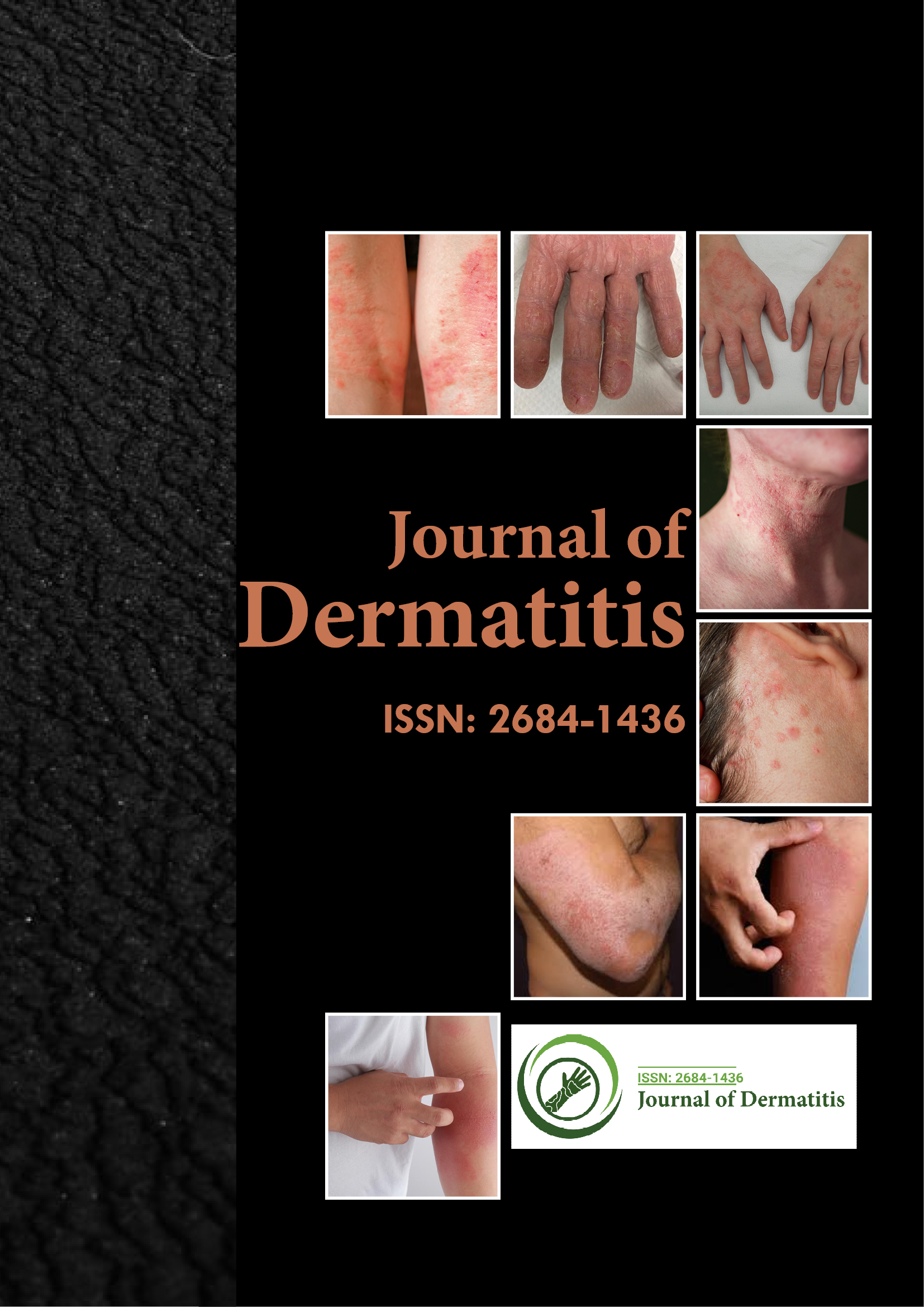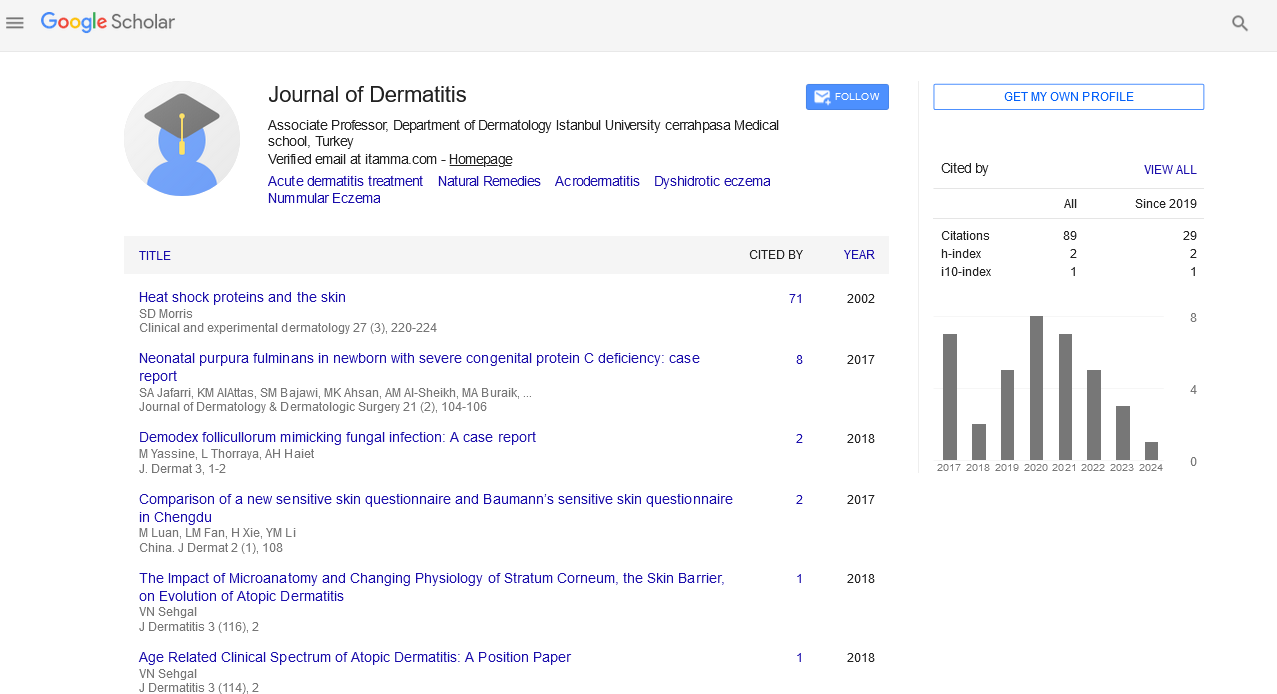Indexed In
- RefSeek
- Hamdard University
- EBSCO A-Z
- Euro Pub
- Google Scholar
Useful Links
Share This Page
Journal Flyer

Open Access Journals
- Agri and Aquaculture
- Biochemistry
- Bioinformatics & Systems Biology
- Business & Management
- Chemistry
- Clinical Sciences
- Engineering
- Food & Nutrition
- General Science
- Genetics & Molecular Biology
- Immunology & Microbiology
- Medical Sciences
- Neuroscience & Psychology
- Nursing & Health Care
- Pharmaceutical Sciences
Perspective - (2023) Volume 8, Issue 6
Genetic Pathways of Atopic Dermatitis: From Immune Dysregulation to Therapeutic Targets
Chuany Wu*Received: 17-Oct-2023, Manuscript No. JOD-23-23951; Editor assigned: 20-Oct-2023, Pre QC No. JOD-23-23951 (PQ); Reviewed: 03-Nov-2023, QC No. JOD-23-23951; Revised: 10-Nov-2023, Manuscript No. JOD-23-23951 (R); Published: 17-Nov-2023, DOI: 10.35248/2684-1436.23.8.226
Description
Atopic Dermatitis (AD), commonly known as eczema, is a chronic inflammatory skin disorder that affects millions of people worldwide. This condition is characterized by itchy, red, and inflamed skin, often accompanied by a rash. While the exact cause of atopic dermatitis remains multifaceted, significant advancements in understanding of its genetic pathways have shed light on the underlying mechanisms that drive this condition. This knowledge has paved the way for the development of novel therapeutic targets, offering hope for better management and treatment of AD.
One of the key components in the genetic pathways of atopic dermatitis is immune dysregulation. The immune system plays a pivotal role in the pathogenesis of AD. People with this condition have a predisposition towards an overactive immune response, leading to the release of pro-inflammatory molecules and immune cells that target the skin. Genetic studies have identified several genes associated with AD, such as Filaggrin (FLG), Thymic Stromal Lymphopoietin (TSLP), and interleukin-4 receptor alpha (IL-4RA). These genes are involved in the regulation of the skin's barrier function, immune signaling, and the differentiation of T-helper cells. Mutations or variations in these genes can disrupt the normal immune response, contributing to the development of atopic dermatitis.
Furthermore, atopic dermatitis often runs in families, indicating a strong genetic component. Individuals with a family history of AD are at a higher risk of developing the condition themselves. Twin studies have also confirmed the hereditary nature of AD, with identical twins more likely to both have AD compared to non-identical twins. This suggests that specific genetic factors, along with environmental triggers, play a critical role in the onset and progression of AD.
The genetic pathways of atopic dermatitis are closely intertwined with environmental factors. Exposure to allergens, pollutants, and irritants can exacerbate the condition. Studies have shown that certain gene-environment interactions can significantly influence the risk of developing AD. For example, the combination of genetic susceptibility and early exposure to allergens like dust mites or pollen can increase the likelihood of developing atopic dermatitis. Identifying these interactions is vital for a comprehensive understanding of the condition and for tailoring individualized treatment approaches.
The elucidation of the genetic pathways of atopic dermatitis has paved the way for the development of targeted therapies. A better understanding of the genes and signaling pathways involved in AD has led to the development of novel treatments that aim to modulate the immune response and restore the skin's barrier function. Biologics, which target specific immune molecules, have shown in managing the inflammation associated with AD. Dupilumab, for instance, is an FDA-approved biologic that inhibits the action of IL-4 and IL-13, two cytokines involved in AD. By targeting these specific molecules, Dupilumab has proven effective in reducing the severity of symptoms in many AD patients.
In addition to biologics, there are ongoing research efforts to develop small molecule inhibitors and other therapies that target the genetic pathways associated with atopic dermatitis. These therapies aim to provide more options for individuals with AD, particularly those who do not respond to existing treatments or experience side effects.
In conclusion, the genetic pathways of atopic dermatitis are complex and involve a combination of genetic susceptibility and environmental triggers. Immune dysregulation is a central aspect of the condition, and research in this field has led to the development of targeted therapies that hold for better management and treatment of AD. For understanding of the genetic underpinnings of atopic dermatitis continues to evolve, it is likely that more effective and personalized treatments will emerge, offering hope to those living with this chronic and often debilitating skin condition.
Citation: Wu C (2023) Genetic Pathways of Atopic Dermatitis: From Immune Dysregulation to Therapeutic Targets. J Dermatitis. 8:226.
Copyright: © 2023 Wu C. This is an open-access article distributed under the terms of the Creative Commons Attribution License, which permits unrestricted use, distribution, and reproduction in any medium, provided the original author and source are credited.

